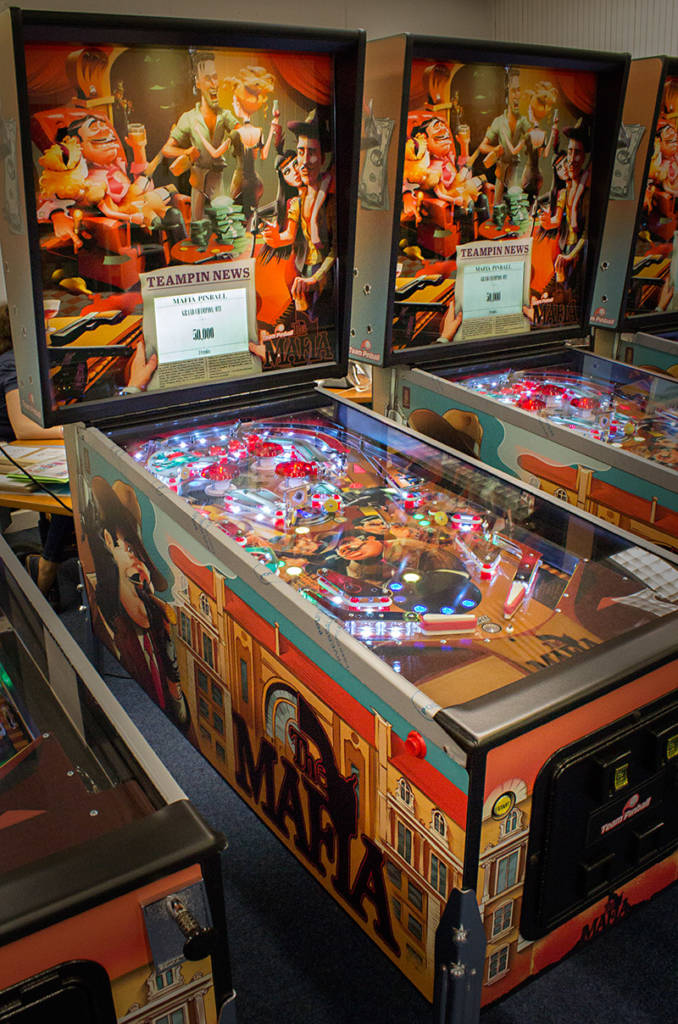
Raspberry Pi Roundup - a Mafia-inspired pinball machine, a computerised shuffleboard and a way to make a wireless access point
An offer you cannot refuse

Janos Kiss, Otília Pasaréti and Romain Fontaine set up a pinball manufacturing company, called Team Pinball, in Cardiff a little over a year ago and have been quietly, and secretly, beavering away on their new machines. The game, based on a Mafia theme, features a 10.1″ LCD built into the back board.
Although most of the mechanical parts in the machine are standard and easily available (for easy replacement in case of breakdowns), the main ‘brain’ inside the machine is a Raspberry Pi 3!

Janos explains the electronics pictured above:
The platform is composed of a Raspberry Pi 3 and a single electronic board (R-board) with through-hole components. The Raspberry Pi 3 runs the game software and interfaces with the machine through the R-board. All the switches are direct switches, they are connected to the R-board and scanned a thousand times every second. The CPU will send responses to the solenoids in less than 3 milliseconds giving sharp feedback and a no-lag experience for the player. The game comes with full RGB LEDs which are also controlled by the CPU. A 12V PSU and a 48V transformer are used for the electronics and the solenoids respectively.
The software on the Pi is a custom Linux operating system called JOS, written in C++.
Machines are made to order by the Cardiff team and the suggested retail price of the units is £6,750, which isn’t bad considering the bespoke nature of the machines!
You can see the trailer for the machines below and read more over at Pinball News. The company’s website can be found here.
Shuffleboard

Grant Gibson was approached by Belgian beer brand Heverlee to create a fun in-bar experience. Grant remembered Sjoelen – a shuffleboard game popular across Germany, Belgium and the Netherlands and thought up a free-standing apparatus to play the game and win prizes. The idea is that players slide wooden pucks down the board and try to get them through the holes beneath the back board. Apparently, it’s more challenging than it sounds!
For detection of the puck, Gibson used IR proximity sensors wired to a Raspberry Pi 3. He added a webcam and screen so that bystanders could see the reactions of the players during the game and then programmed the Pi in Python to bring it all together.
The prizes are cans of the Belgian beer in question and these are dispensed by the Pi, via 12V relays using a self-manufactured mechanism. The story of how he got to this mechanism, and the… dampness involved when it all went wrong… are covered over on his blog.
Some more making was involved in bringing the game up to a standard suitable for transporting and abuse from slightly drunk players!
You can read more about the project over on Gibson’s blog or watch the video below:
Wireless Access Point

There have been lots of tutorials about how to create a Raspberry Pi wireless access point in the past, but they have become slightly out of date over time. This new one from the May 2018 issue of Maximum PC is much better than some I’ve read and goes through all the steps you’ll need to go through including installing software, configuring DNS and DHCP, configuring HostAPD, thinking about traffic shaping and making a bridge between connections. To find out how to do it, head over to PC Gamer.








